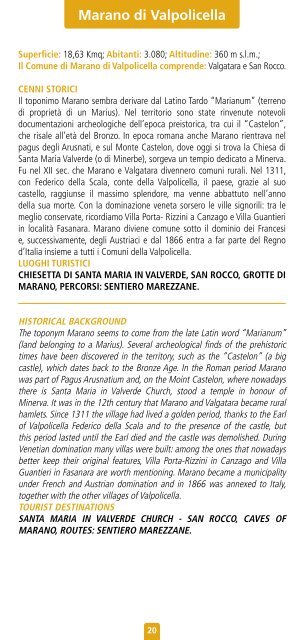Valpolicella Web
Valpolicella Web
Valpolicella Web
Create successful ePaper yourself
Turn your PDF publications into a flip-book with our unique Google optimized e-Paper software.
Marano di <strong>Valpolicella</strong><br />
Superficie: 18,63 Kmq; Abitanti: 3.080; Altitudine: 360 m s.l.m.;<br />
Il Comune di Marano di <strong>Valpolicella</strong> comprende: Valgatara e San Rocco.<br />
CENNI STORICI<br />
Il toponimo Marano sembra derivare dal Latino Tardo “Marianum” (terreno<br />
di proprietà di un Marius). Nel territorio sono state rinvenute notevoli<br />
documentazioni archeologiche dell’epoca preistorica, tra cui il “Castelon”,<br />
che risale all’età del Bronzo. In epoca romana anche Marano rientrava nel<br />
pagus degli Arusnati, e sul Monte Castelon, dove oggi si trova la Chiesa di<br />
Santa Maria Valverde (o di Minerbe), sorgeva un tempio dedicato a Minerva.<br />
Fu nel XII sec. che Marano e Valgatara divennero comuni rurali. Nel 1311,<br />
con Federico della Scala, conte della <strong>Valpolicella</strong>, il paese, grazie al suo<br />
castello, raggiunse il massimo splendore, ma venne abbattuto nell’anno<br />
della sua morte. Con la dominazione veneta sorsero le ville signorili: tra le<br />
meglio conservate, ricordiamo Villa Porta- Rizzini a Canzago e Villa Guantieri<br />
in località Fasanara. Marano diviene comune sotto il dominio dei Francesi<br />
e, successivamente, degli Austriaci e dal 1866 entra a far parte del Regno<br />
d’Italia insieme a tutti i Comuni della <strong>Valpolicella</strong>.<br />
LUOGHI TURISTICI<br />
CHIESETTA DI SANTA MARIA IN VALVERDE, SAN ROCCO, GROTTE DI<br />
MARANO, PERCORSI: SENTIERO MAREZZANE.<br />
HISTORICAL BACKGROUND<br />
The toponym Marano seems to come from the late Latin word “Marianum”<br />
(land belonging to a Marius). Several archeological finds of the prehistoric<br />
times have been discovered in the territory, such as the “Castelon” (a big<br />
castle), which dates back to the Bronze Age. In the Roman period Marano<br />
was part of Pagus Arusnatium and, on the Moint Castelon, where nowadays<br />
there is Santa Maria in Valverde Church, stood a temple in honour of<br />
Minerva. It was in the 12th century that Marano and Valgatara became rural<br />
hamlets. Since 1311 the village had lived a golden period, thanks to the Earl<br />
of <strong>Valpolicella</strong> Federico della Scala and to the presence of the castle, but<br />
this period lasted until the Earl died and the castle was demolished. During<br />
Venetian domination many villas were built: among the ones that nowadays<br />
better keep their original features, Villa Porta-Rizzini in Canzago and Villa<br />
Guantieri in Fasanara are worth mentioning. Marano became a municipality<br />
under French and Austrian domination and in 1866 was annexed to Italy,<br />
together with the other villages of <strong>Valpolicella</strong>.<br />
TOURIST DESTINATIONS<br />
SANTA MARIA IN VALVERDE CHURCH - SAN ROCCO, CAVES OF<br />
MARANO, ROUTES: SENTIERO MAREZZANE.<br />
20





